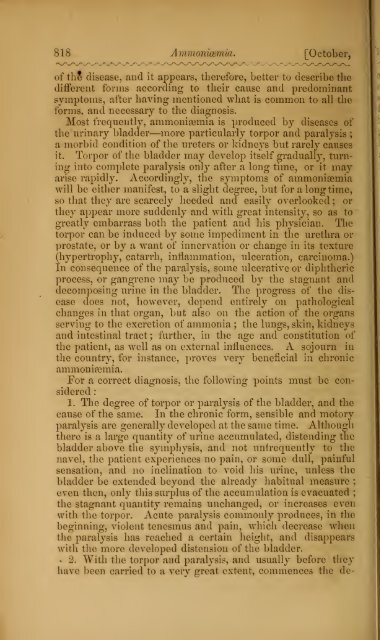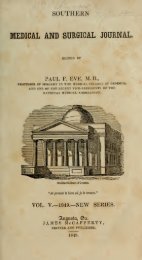L861.Jlid. 817in Blight's disease, before the uriuiferous tubes beconie impervious; but true ajnmoniaamia is the consequence of urine,in a - decomposition, being received into the blood ; anoccurrence which may ha<strong>pp</strong>en either from a torpid or paralyzedstate of the urinary bladder, from dilatation of Malpighi'spyramids and the renal pelvis while the ureters arcimpervious, or from abscess, tuberculosis and other diseases ofthe kidneys. The urine has, in this disease, always a pungent,ammoniacal odor ; hydrops is never connected with ammonisemia,but there is a persistent dryness of the mucousmembrane of the mouth and fauces; the patient feeling as ifeven* particle of humidity had been dried up by someabsorbent. Sometimes this dryness will spread to the Schneiderianmembrane, the conjunctiva of the eye, and the ligamentsof the larynx, producing hoarseness or aphonia. Thereis always a strong and well-marked ammoniacal odor in theair expired by the patient ; and the same odor is perceived bylifting the bedclothes. A great aversion to meat is neverwanting-, and violent intermittent chills arc of frequent occurence; while neither convulsive fits, nor croups, nor diphthericexudations have been observed during the disease we aretreating of, nor have disturbances of the vision been noticed.A constant symptom is a singular grayish discoloration of theface, with progressive emaciation ; very acute cases are accompaniedby a rapid collapse of the features, and a muscularweakness bordering on paralysis. In such acute cases, vomiting,accompanied or followed by diarrhoea, is always present:ldom, or only for a short, time, occurs in the chronic formof the disease. Death is always preceded by a soporous state,lasting fmm a few hours l several days.Acute ammoniaunia runs its course in a few (from two tosix) days, and terminates, if properly attended to, in recovery ;if not, in death. More or Less vomiting is usually the firstsymptom in such cases ;often soon followed by febrile manitestations, rapid collapse and sopor.The chronic form may last weeks, months and years, withtemporary improvements and changes for the Averse ; it canterminate favorably, even after a long time, if recognised andcorrectly treated ; but may induce death in spite of all treatmentwhen its causes cannot be removed. There are alwaysccompanying chronic ammonhemia, butthey are often mistaken for catarrh of the gastric and intestinalmucous membra' may also occur which simulatetyphoid or intermittent fever. On account of these varyingsymptoms, it is rather difficult t give a good description
818 Ammoniamia. [<strong>October</strong>,v^^%/\yof the* disease, and it a<strong>pp</strong>ears, therefore, better to describe thedifferent forms according to their cause and predominantsymptoms, after having mentioned what is common to all theforms, and necessary to the diagnosis.Most frequently, ammoniajmia is produced by diseases ofthe urinary bladder—more particularly torpor and paralysis ;a morbid condition of the ureters or kidneys but rarely causesit. Torpor of the bladder may develop itself gradually, turninginto complete paralysis only after a long time, or it mayarise rapidly. Accordingly, the symptoms of ammonisemiawill be either manifest, to a slight degree, but for a long time,so that they are scarcely heeded and easily overlooked ; orthey a<strong>pp</strong>ear more suddenly and with great intensity, so as togreatly embarrass both the patient and his physician. Thetorpor can be induced by some impediment in the urethra orprostate, or by a want of innervation or change in its texture(hypertrophy, catarrh, inflammation, ulceration, carcinoma.)In consequence of the paralysis, some ulcerative or diphthericprocess, or gangrene may be produced by the stagnant anddecomposing urine in the bladder. The progress of the diseasedoes not, however, depend entirely on pathologicalchanges in that organ, but also on the action of the organsserving to the excretion of ammonia ; the lungs, skin, kidneysand intestinal tract ; further, in the age and constitution ofthe patient, as well as on external influences. A sojourn inthe country, for instance, proves very beneficial in chronicammoniremia.For a correct diagnosis, the following points must be considered:1. The degree of torpor or paralysis of the bladder, and thecause of the same. In the chronic form, sensible and motoryparalysis are generally developed at the same time. Althoughthere is a large quantity of urine accumulated, distending thebladder above the symphysis, and not unfrequently to thenavel, the patient experiences no pain, or some dull, painfulsensation, and no inclination to void his urine, unless thebladder be extended beyond the already habitual measure ;even then, only this surplus of the accumulation is evacuated ;the stagnant quantity remains unchanged, or increases evenwith the torpor. Acute paralysis commonly produces, in thebeginning, violent tenesmus and pain, which decrease whenthe paralysis has reached a certain height, and disa<strong>pp</strong>earswith the more developed distension of the bladder.. 2. With the torpor and paralysis, and usually before theyhave been carried to a very great extent, commences the de-
- Page 1 and 2:
SOUTHERNfttcMcai avto Surgical Imtt
- Page 3 and 4:
practical754 i;i'Ji J'oXes, on the
- Page 5 and 6:
756 Joseph Jones, on the Indigenous
- Page 7 and 8:
;7 58 Joseph J ones, on the Indigen
- Page 9 and 10:
760 Joseph Jones, on the Indigenous
- Page 11 and 12:
762 3EPflJoKfis, bn the Indigenous
- Page 13 and 14:
764 Joseph Jones, on the Indigenous
- Page 15 and 16: 7'!
- Page 17 and 18: —'.emeticssbfhJohi[Octobameliorat
- Page 19 and 20: 770 Joseph Jones, on the Indigenous
- Page 21 and 22: 77-? Joseph Jones, on the Indigenou
- Page 23 and 24: 7 74 Joseph Jones, on the Indigenou
- Page 25 and 26: 776 Joseph Jones, on 1 the Indigeno
- Page 27 and 28: 778 Joseph Jones, on the Indigenous
- Page 29 and 30: 780 Joseph Jokes, on (he Indigenous
- Page 31 and 32: 782 Joseph Jones, on the Indigenous
- Page 33 and 34: :784 Joseph Jones, on the Indigenou
- Page 35 and 36: —786 Joseph Jones, on the Indigen
- Page 37 and 38: 788 Dvphtlima. [October,to confound
- Page 39 and 40: 700 Diphtheria. [October,*almost in
- Page 41 and 42: 792 Diphtheria. [October,in water a
- Page 43 and 44: 704 Diphtheria: [October,find favor
- Page 45 and 46: 796 Diphtheria. [October,tongue. \)
- Page 47 and 48: 798 Uterine Inflammation. October,b
- Page 49 and 50: 800 Uterine Inflammation. [October,
- Page 51 and 52: 802 Uterine Inflammation. [October,
- Page 53 and 54: elhrai804 me Inflammation. [October
- Page 55 and 56: ;806 Phlegmasia Dolens. [October,Th
- Page 57 and 58: SOS Termination ofNerves. [October,
- Page 59 and 60: cl Termination of Nerv October,] to
- Page 61 and 62: —812 Development of Bloodvessels.
- Page 63 and 64: —814 ( orpuscles of the Spleen. [
- Page 65: —Mi; Ammomcemh. [October,tubes in
- Page 69 and 70: 820 Arnmoniccraia. [October,combine
- Page 71 and 72: 822 Ammonicemia, [October,all, requ
- Page 73 and 74: 824 Galcano Cautery in Cataract. [O
- Page 75 and 76: —826 Editorial. [October,MEDICAL
- Page 77 and 78: ———828 Miscellaneous. [Octobe
- Page 79 and 80: ———830 Miscellaneous. [Octobe
- Page 81: —832 Miscellaneous.was employed f








